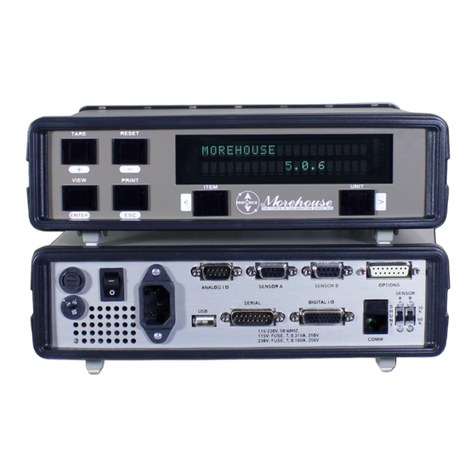
10/20/2022 Page 1 of 20 Rev: 1
Instruction Manual PM-5947 Copyright © 2022
Table of Contents
DISPLAY & KEYPAD DETAILS ........................................................................................ 2
INSTALLATION & OVERVIEW ......................................................................................... 4
Installation of C705P force data instrument .......................................................... 4
Power Connections (AC version) .......................................................................... 5
USB Port ............................................................................................................... 5
Getting Started ...................................................................................................... 5
SYSTEM CONFIGURATION ............................................................................................ 6
1.1 Configuration Menus ....................................................................................... 6
1.2 Entering the Setup (“F”) Configuration Menu .................................................. 7
1.3 Leaving the Setup (“F”) Configuration Menu ................................................... 7
1.4 Setup (“F”) Menu Descriptions ........................................................................ 8
1.5 Entering the Polynomial (“P”) Configuration Menu .......................................... 8
1.6 Leaving the Polynomial Setup (“P”) Configuration Menu ................................ 9
1.7 Polynomial Setup (“P”) Menu Descriptions ..................................................... 9
1.8 Entering the General (“G”) Configuration Menu ............................................ 10
1.9 Leaving the General (“G”) Configuration Menu ............................................. 11
1.10 General (“G”) Menu Descriptions ................................................................ 11
1.11 Entering the User/COM1 (“A1”) Menu ......................................................... 12
1.12 Leaving the User/COM1 (“A1”) Configuration Menu ................................... 13
1.13 User/COM1 (“A1”) Menu Descriptions ........................................................ 14
1.14 Entering the COM2 (“A2”) Menu ................................................................. 14
1.15 Leaving the COM2 (“A2”) Configuration Menu ............................................ 15
1.16 COM2 (“A2”) Menu Descriptions ................................................................. 15
INSTRUMENT CALIBRATION ........................................................................................ 16
2.1 Calibration Overview ..................................................................................... 16
2.2 Live Calibration Overview ............................................................................. 16
2.3 Live Span Calibration Instructions (PFx-F17) ................................................ 17
2.4 Live Negative Span Calibration Instructions (PFx-F15) ................................ 17
2.5 Live Calibration - Zero Instructions (PFx-F16) .............................................. 18
2.6 Entering B coefficient values for Compression Negative Span (PFx-CBx) ... 18
2.7 Entering B coefficient values for Tension Positive Span (PFx-TBx) .............. 18
2.8 Reference (mV/V) Calibration - Zero Instructions (G16) ............................... 19
2.9 Reference (mV/V) Calibration - Span Instructions (G17) .............................. 19
ADVANCED OPERATION .............................................................................................. 20
3.1 Peak Hold Mode ........................................................................................... 20
SERIAL PORT INFO ....................................................................................................... 20
OUTPUT STRINGS ........................................................................................................ 20






























